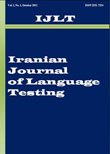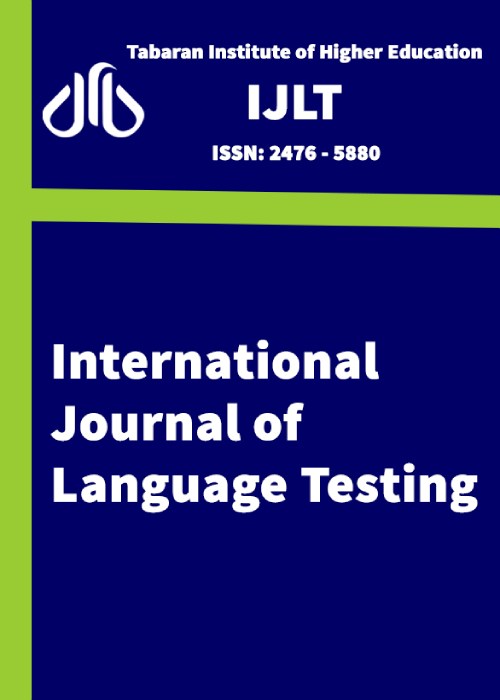فهرست مطالب

International Journal of Language Testing
Volume:2 Issue: 2, Oct 2012
- تاریخ انتشار: 1392/01/18
- تعداد عناوین: 6
-
Page 93In this paper, we aim to introduce Life-Language Test as a new concept in the field of language testing, drawing on recent trends in the field of English language teaching. To do so, we try to explain ways in which language testing professionals can revise and devise tests for measuring both learners’ language proficiency and other issues which are of prime importance in their life. We first conduct a historical review of prominent language proficiency models which have formed the basis for devising language tests; next, we discuss the theory of Applied ELT, as well as its related nomenclature, which stresses the promotion of learners’ quality of life in English language classes. Finally, we propose Life-Language Model of Proficiency which is an extension of previous models. After providing evidence supporting the construct validity of life-language tests, we contend that language testing is now ripe enough for a broader view of assessment which would include related issues from other disciplines. We further argue that language testing has a lot to offer to other disciplines and that language testers should adopt new roles as Educational Language Testers.Keywords: Applied ELT, Construct validity, Educational Language Testing, Life, Language model of proficiency, Life, Language Test, Life issues
-
Page 109In their paper, Professors Pishghadam and Zabihi have presented the language testing profession with a challenge to begin to produce tests that measure not only language ability but also “issues of primary concern in learners’ life” (p. 7). They argue that English language teaching has matured to the point where it can be viewed as independent of other domains of knowledge and thus should abandon “the traditional linguistic syllabuses which are typically used in ELT” and focus more on “useful aspects of learners’ lives in the ELT curriculum” (p. 9). Consequently, they reason, English language testing should likewise change from a focus solely on language to “the incorporation of useful aspects of learners’ lives into a comprehensive test which underpins practical life issues as well as language-related issues” (p. 7). As a language tester who has a professional interest in assessing language for specific purposes (LSP), I was immediately attracted to this philosophy since LSP is all about assessing the ability to use language in situations of importance in the lives of language learners. I have argued, in fact, that a specific purpose language test is one in which “test content and methods are derived from an analysis of a specific purpose target language use situation” in which language users wish to engage (Douglas 2000, p. 19). Certainly the notions of “English for Life Purposes” and “Life-Language Test” that the authors of this paper outline appear to fit particularly well with my own vision of the importance of language for specific purposes and LSP testing
-
Page 112The intriguing article, Establishing a life-language model of proficiency: A new challenge for language testers, raises two concerns. First, the proposed construct of a “life-language model” of proficiency in the hands of “Educational Language Testers” would require the measurement of “the psychological, emotional, and social needs of learners (through careful design of Life- Language Tests)” (p. 97). This is a very broad definition of proficiency indeed, more suited to other kinds of tests, namely diagnostic tests. Second, the proposed construct of critical thinking, which is highlighted within the discussion of the Life-Language Test, may be more of a proxy measure for intelligence testing than critical thinking which, it is argued, is embedded within disciplinary cultures. Each of these concerns is discussed below.
-
Page 116In the article, written by Dr. Pishghadam and his student Zabihi, the authors have outlined an interesting approach to language assessment that deserves wider discussion. We would note strengths in the manuscript, particularly the topic area under consideration which is a timely and important one as the authors try to offer a novel way of thinking about the issues at hand and ways of conceptualizing the notion of adequate English language testing. The statement of the problem is clear: the authors state that their aim is to “introduce Life-Language Test as a new concept in the field of language testing, drawing on recent trends in the field of English language teaching and, in so doing, try to explain ways in which language testing professionals can revise and devise tests for measuring both learners’ language proficiency and other issues which are of prime importance in their life” (p. 93).
-
Page 120The 2012 article, authored by Pishghadam and Zabihi (henceforth P & Z), published in the October issue of the Iranian Journal of Language Testing represents research in the area of language testing and test development that promises to go beyond the development of language tests that measure language per se by addressing learners’ ‘life-related’ issues. The article purports to offer a new model of language proficiency and its applications in the area of language testing and test development.
-
Page 126In their article published in the second volume of the Iranian Journal of Language Assessment, Professors Pishghadam and Zabihi make a praiseworthy attempt to stress the importance of uses of language tests in real life situations. They explain the “life-language model of proficiency” and its application to language assessment and pedagogy. Pishghadam and Zabihi’s examination of literature is fairly thorough, although several important theories which would be highly relevant are missing. In this commentary, we will focus primarily on the assessment and validation issues observed in the article, as other issues have been thoroughly discussed by other commentators in this volume. We will further show that the concerns raised by Pishghadam and Zabihi are partly reminiscent of the notions put forward by the Common European Framework of Reference and can partly be traced back to the 1980’s. As a final point, we will discuss the shortcomings of their framework and validity argument in light of the current language assessment literature (Fox, 2005; Fulcher & Davidson, 2009; Bachman & Palmer, 2010).


